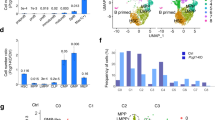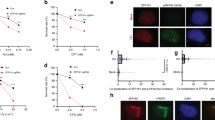Abstract
CREB (cyclic AMP response element-binding protein) is a transcription factor overexpressed in normal and neoplastic myelopoiesis and regulates cell cycle progression, although its oncogenic mechanism has not been well characterized. Replication factor C3 (RFC3) is required for chromatin loading of proliferating cell nuclear antigen (PCNA) which is a sliding clamp platform for recruiting numerous proteins in the DNA metabolism. CREB1 expression, which was activated by E2F, was coupled with RFC3 expression during the G1/S progression in the KG-1 acute myeloid leukemia (AML) cell line. There was also a direct correlation between the expression of RFC3 and CREB1 in human AML cell lines as well as in the AML cells from the patients. CREB interacted directly with the CRE site in RFC3 promoter region. CREB-knockdown inhibited primarily G1/S cell cycle transition by decreasing the expression of RFC3 as well as PCNA loading onto the chromatin. Exogenous expression of RFC3 was sufficient to rescue the impaired G1/S progression and PCNA chromatin loading caused by CREB knockdown. These studies suggest that RFC3 may have a role in neoplastic myelopoiesis by promoting the G1/S progression and its expression is regulated by CREB.
This is a preview of subscription content, access via your institution
Access options
Subscribe to this journal
Receive 12 print issues and online access
$259.00 per year
only $21.58 per issue
Buy this article
- Purchase on Springer Link
- Instant access to full article PDF
Prices may be subject to local taxes which are calculated during checkout







Similar content being viewed by others
References
Frohling S, Scholl C, Gilliland DG, Levine RL . Genetics of myeloid malignancies: pathogenetic and clinical implications. J Clin Oncol 2005; 23: 6285–6295.
Crans-Vargas HN, Landaw EM, Bhatia S, Sandusky G, Moore TB, Sakamoto KM . Expression of cyclic adenosine monophosphate response-element binding protein in acute leukemia. Blood 2002; 99: 2617–2619.
Mayr B, Montminy M . Transcriptional regulation by the phosphorylation-dependent factor CREB. Nat Rev Mol Cell Biol 2001; 2: 599–609.
Siu YT, Jin DY . CREB–a real culprit in oncogenesis. FEBS J 2007; 274: 3224–3232.
Shankar DB, Cheng JC, Kinjo K, Federman N, Moore TB, Gill A et al. The role of CREB as a proto-oncogene in hematopoiesis and in acute myeloid leukemia. Cancer Cell 2005; 7: 351–362.
Sandoval S, Kraus C, Cho EC, Cho M, Bies J, Manara E et al. Sox4 cooperates with CREB in myeloid transformation. Blood 2012; 120: 155–165.
Stoimenov I, Helleday T . PCNA on the crossroad of cancer. Biochem Soc Trans 2009; 37: 605–613.
Prosperi E . The fellowship of the rings: distinct pools of proliferating cell nuclear antigen trimer at work. FASEB J 2006; 20: 833–837.
Moldovan GL, Pfander B, Jentsch S . PCNA the maestro of the replication fork. Cell 2007; 129: 665–679.
Maga G, Hubscher U . Proliferating cell nuclear antigen (PCNA): a dancer with many partners. J Cell Sci 2003; 116: 3051–3060.
Scovassi AI, Prosperi E . Analysis of proliferating cell nuclear antigen (PCNA) associated with DNA. Methods Mol Biol 2006; 314: 457–475.
Erzberger JP, Berger JM . Evolutionary relationships and structural mechanisms of AAA+ proteins. Annu Rev Biophys Biomol Struct 2006; 35: 93–114.
Kim J, MacNeill SA . Genome stability: a new member of the RFC family. Curr Biol 2003; 13: R873–R875.
Lockwood WW, Thu KL, Lin L, Pikor LA, Chari R, Lam WL et al. Integrative genomics identified RFC3 as an amplified candidate oncogene in esophageal adenocarcinoma. Clin Cancer Res 2012; 18: 1936–1946.
Majka J, Burgers PM . The PCNA-RFC families of DNA clamps and clamp loaders. Prog Nucleic Acid Res Mol Biol 2004; 78: 227–260.
Maeng S, Kim GJ, Choi EJ, Yang HO, Lee DS, Sohn YC . 9-Cis-retinoic acid induces growth inhibition in retinoid-sensitive breast cancer and sea urchin embryonic cells via retinoid X receptor alpha and replication factor C3. Mol Endocrinol 2012; 26: 1821–1835.
Whitfield ML, Sherlock G, Saldanha AJ, Murray JI, Ball CA, Alexander KE et al. Identification of genes periodically expressed in the human cell cycle and their expression in tumors. Mol Biol Cell 2002; 13: 1977–2000.
Cheng JC, Kinjo K, Judelson DR, Chang J, Wu WS, Schmid I et al. CREB is a critical regulator of normal hematopoiesis and leukemogenesis. Blood 2008; 111: 1182–1192.
O'Connell RM, Chaudhuri AA, Rao DS, Baltimore D . Inositol phosphatase SHIP1 is a primary target of miR-155. Proc Natl Acad Sci USA 2009; 106: 7113–7118.
Salmon P, Trono D . Production and titration of lentiviral vectors. Curr Protoc Hum Genet 2007; Chapter 12: Unit 12.10.
Livak KJ, Schmittgen TD . Analysis of relative gene expression data using real-time quantitative PCR and the 2(-Delta Delta C(T)) Method. Methods 2001; 25: 402–408.
Galiveti CR, Rozhdestvensky TS, Brosius J, Lehrach H, Konthur Z . Application of housekeeping npcRNAs for quantitative expression analysis of human transcriptome by real-time PCR. RNA 2010; 16: 450–461.
Chaves-Perez A, Mack B, Maetzel D, Kremling H, Eggert C, Harreus U et al. EpCAM regulates cell cycle progression via control of cyclin D1 expression. Oncogene 2013; 32: 641–650.
Lavine JA, Raess PW, Davis DB, Rabaglia ME, Presley BK, Keller MP et al. Overexpression of pre-pro-cholecystokinin stimulates beta-cell proliferation in mouse and human islets with retention of islet function. Mol Endocrinol 2008; 22: 2716–2728.
Pellegrini M, Cheng JC, Voutila J, Judelson D, Taylor J, Nelson SF et al. Expression profile of CREB knockdown in myeloid leukemia cells. BMC Cancer 2008; 8: 264.
Malumbres M, Barbacid M . Cell cycle, CDKs and cancer: a changing paradigm. Nat Rev Cancer 2009; 9: 153–166.
Ji JY, Dyson NJ . Interplay between cyclin-dependent kinases and E2F-dependent transcription. In: Enders GH (ed). Cell Cycle Deregulation in Cancer Springer: New York, 2010; pp 23–41.
Takasaki Y, Deng JS, Tan EM . A nuclear antigen associated with cell proliferation and blast transformation. J Exp Med 1981; 154: 1899–1909.
Ashton NW, Bolderson E, Cubeddu L, O'Byrne KJ, Richard DJ . Human single-stranded DNA binding proteins are essential for maintaining genomic stability. BMC Mol Biol 2013; 14: 9.
Squires MS, Feltell RE, Wallis NG, Lewis EJ, Smith DM, Cross DM et al. Biological characterization of AT7519, a small-molecule inhibitor of cyclin-dependent kinases, in human tumor cell lines. Mol Cancer Therapeut 2009; 8: 324–332.
Tsurimoto T . PCNA binding proteins. Front Biosci 1999; 4: D849–D858.
Pramila T, Miles S, GuhaThakurta D, Jemiolo D, Breeden LL . Conserved homeodomain proteins interact with MADS box protein Mcm1 to restrict ECB-dependent transcription to the M/G1 phase of the cell cycle. Genes Dev 2002; 16: 3034–3045.
Bakshi S, Zhang X, Godoy-Tundidor S, Cheng RY, Sartor MA, Medvedovic M et al. Transcriptome analyses in normal prostate epithelial cells exposed to low-dose cadmium: oncogenic and immunomodulations involving the action of tumor necrosis factor. Environ Health Perspect 2008; 116: 769–776.
Henneke G, Koundrioukoff S, Hubscher U . Multiple roles for kinases in DNA replication. EMBO Rep 2003; 4: 252–256.
Shankar DB, Cheng JC, Sakamoto KM . Role of cyclic AMP response element binding protein in human leukemias. Cancer 2005; 104: 1819–1824.
Sandoval S, Pigazzi M, Sakamoto KM . CREB: a key regulator of normal and neoplastic hematopoiesis. Adv Hematol 2009; 2009: 634292.
Pigazzi M, Manara E, Baron E, Basso G . miR-34b targets cyclic AMP-responsive element binding protein in acute myeloid leukemia. Cancer Res 2009; 69: 2471–2478.
Chen HZ, Tsai SY, Leone G . Emerging roles of E2Fs in cancer: an exit from cell cycle control. Nat Rev Cancer2009; 9: 785–797.
Tan Z, Wortman M, Dillehay KL, Seibel WL, Evelyn CR, Smith SJ et al. Small-molecule targeting of proliferating cell nuclear antigen chromatin association inhibits tumor cell growth. Mol Pharmacol 2012; 81: 811–819.
Shimada M, Okuzaki D, Tanaka S, Tougan T, Tamai KK, Shimoda C et al. Replication factor C3 of Schizosaccharomyces pombe, a small subunit of replication factor C complex, plays a role in both replication and damage checkpoints. Mol Biol Cell 1999; 10: 3991–4003.
Acknowledgements
This research was supported by NIH R01 HL75826 (KMS), and by the American Cancer Society Greeley & Seattle Gala/Friends of Rob Kinas Postdoctoral Fellowship and the Stanford University Dean’s Post-Doctoral Fellowship program (BM). Sorting was performed on an instrument in the Shared FACS Facility obtained using NIH S10 Shared Instrument Grant S10RR025518-0. We thank Dr Young-June Kim for helpful comments and discussion on the manuscript.
Author information
Authors and Affiliations
Corresponding author
Ethics declarations
Competing interests
The authors declare no conflict of interest.
Rights and permissions
About this article
Cite this article
Chae, HD., Mitton, B., Lacayo, N. et al. Replication factor C3 is a CREB target gene that regulates cell cycle progression through the modulation of chromatin loading of PCNA. Leukemia 29, 1379–1389 (2015). https://doi.org/10.1038/leu.2014.350
Received:
Revised:
Accepted:
Published:
Issue Date:
DOI: https://doi.org/10.1038/leu.2014.350
This article is cited by
-
Essential function of adaptor protein Nck1 in platelet-derived growth factor receptor signaling in human lens epithelial cells
Scientific Reports (2022)
-
Revealing transcription factor and histone modification co-localization and dynamics across cell lines by integrating ChIP-seq and RNA-seq data
BMC Genomics (2018)
-
Small molecule inhibition of cAMP response element binding protein in human acute myeloid leukemia cells
Leukemia (2016)



